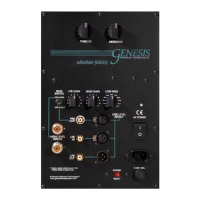ver 1.3
15
1515
15
~ÄëçäìíÉ=ÑáÇÉäáíó
the midrange driver. This would tend to sound "boomy" in the mid bass
regions.
Another good rule of thumb is to first set the BASS GAIN control of the
woofer for proper mid-bass rather than low bass. The theory is that if
the mid-bass is correct, then the low bass should be very close to
correct.
A good balance between proper low bass extension and a deep and
spacious soundstage needs to be established to optimize your new
speaker's performance.
In order to achieve what the speaker is capable of we suggest you focus
your efforts on a proper balance of soundstage elements that includes
information beyond the left and right sides of the speakers, front to back
depth well behind the speaker, excellent focus of instruments and voices
with proper vertical information and mid bass fill.
A Genesis loudspeaker system correctly set up, can and should provide
a soundstage that is wall to wall and with pinpoint focus, the speakers
disappearing completely on a recording containing such information.
4.4 Room Treatment
No room is perfect. To optimize your sonic
presentation it may be helpful to treat your room.
Here are some guidelines:
Front walls. This loudspeaker is a dipole and
therefore there is sound coming from both the
front and the back of the speaker. How the front
wall (the wall you face while listening) is treated
or not treated is important. Generally speaking,
the Genesis loudspeakers prefer a live (hard
reflective) front wall to a dead (soft absorbent)
front wall.
By these terms we mean the amount of reflection
of sound. A typical wall of glass, brick, cement
or drywall material is a reflective surface. A
heavily curtained or sound-proofed wall would be
considered a "dead wall" or a non-reflective wall.
A normal thin curtain across a window causes
only a small amount of absorption.

